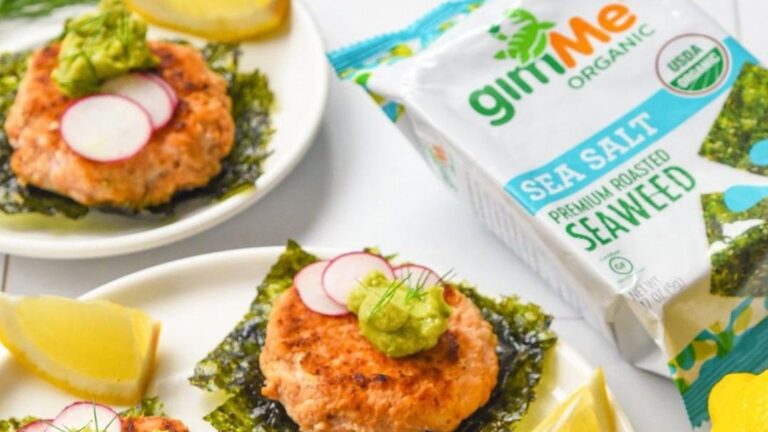
Gimme reinvents how seaweed is included into meals.
give me
Annie Chun, who grew up in South Korea, already has a profitable enterprise below her belt. Now she’s constructing her second with only one ingredient: algae.
When Chun got here to San Francisco within the late Seventies, she ended up within the grocery enterprise, starting like so many different meals entrepreneurs on the farmer’s market. Within the early ’90s, she conquered native markets along with her Asian-inspired sauces. In 2009, she and her husband Steve Broad, who can be her staunch enterprise accomplice, bought that first enterprise, Annie’s Chun’s Meals, to CJ’s, a South Korean firm after reportedly producing $15 million in annual gross sales.
Gimme founders Steve Broad and Annie Chun.
©Lori Eanes
In 2012, Chun wished to begin a distinct enterprise that will remind her of the seaweed snacks she grew up consuming in South Korea. GimMe was born. “There was nothing like that available on the market. And positively not natural.”
Chun and Broad had a giant activity forward of them. Not solely did they modify the best way seaweed was harvested off the coast of South Korea, however in addition they needed to introduce American shoppers to a comparatively new idea: a snack with a chip-like texture however an earthy, salty style of the ocean.
The duo had capitalized on the success of their earlier enterprise; In order that they put a portion of the income from that enterprise into beginning this new firm. “With the sauces, there have been too many particular person elements to make it natural. It was troublesome to get copacker to afford this additional effort. However with seaweed, it is only one principal ingredient,” notes Chun.
The Bay Space resident, who had beforehand been an natural meals advocate, now had the chance to launch an all-organic product line whereas working intently along with her provide chain.
Seaweed, a staple within the Japanese and Korean diets, has been confined to ethnic grocery cabinets in america. Additionally, Chun wished to make it extra palatable to American tastes. So she developed a crunchier, chip-like model that is available in quite a lot of flavors: teriyaki, wasabi, sesame, avocado oil, chilli-lime, and extra.
Seaweed can be a nutrient-dense meals, Chun explains. “If you cannot add anything to the rice, simply mash up some seaweed and put it on prime.” Seaweed comprises iodine, omega-3, iron, calcium, fiber, protein, amongst different vitamins. “It is a very nutrient dense meals for its weight,” Broad explains. “And if we have to search for extra vegetarian choices, it is an important selection since we have overfished our seas.”
It has additionally develop into a preferred ingredient for its environmental properties. Algae could be grown on regenerative natural farms, in line with the Ellen MacArthur Basis. Not like land-based farms, which require massive quantities of exterior inputs for his or her crops, algae generally is a lower-maintenance crop. Algae may also help regenerate the marine ecosystem by lowering ocean acidification and offering habitat for myriad marine species. It’s estimated {that a} 20-hectare farm can take in 9,000 kilograms of CO2 and 300 kilograms of nitrogen yearly.
GimMe states that one tonne of algae can take in round one to 4 tons of CO2 per 12 months and might typically take in two to 5 occasions the quantity of CO2 than tropical forests just like the Amazon.
Gimme sources natural seaweed from these farms off the coast of South Korea.
LEEJAEEUN
Natural farming provides one other layer to this environmental story. Broad explains that their course of differs from standard growers. GimMe’s seaweed is grown within the deeper waters of Jangheung Bay, he says. “They use buoys. When the seaweed is submerged within the water, it grows. Then they spin it and expose it to the solar over water. This kills all species that may harm the algae and switch them brown.”
This pure strategy to rising seaweed avoids using chemical compounds or components that might probably hurt marine life.
When Chun first launched the natural seaweed to some nationwide meals retailers, she did not get a really enthusiastic response. When she went to Complete Meals, she says, “The patron understood it immediately and understood the value of natural. After which launched us nationwide.”
For Chun, rising GimMe was a mix of passing on her Korean heritage and creating wholesome and inexpensive snacks. “For me, this firm is about sharing, sharing my roots, but additionally sharing one thing that is good for our well being.”
Nonetheless, packing was not simple. The seaweed chips have to be stored contemporary; the packaging should due to this fact have a high oxygen barrier. For years they lay in plastic trays, wrapped in foil. Broad explains that they’ve now achieved away with the plastic bowls and are consistently on the lookout for higher options. GimMe companions with OSC, One Step Nearer Packaging Collaborative, within the Bay Space, which is made up of comparable sustainability-focused corporations on the lookout for greener packaging options.
As an organization with round 20 workers, Broad says: “We’re nonetheless small and it’s troublesome to remodel a packaging business on our personal. However we’re at all times looking for higher choices.”
In the course of the pandemic, when sushi eating places have been shutting down, GimMes nori grew to become a staple for sushi DIYers, he provides. That has helped the corporate onboard a brand new demographic. “However the wonderful factor is that we’ve got youngsters sharing the snacks in colleges and meaning youngsters are uncovered to algae. Additionally, we have seen some large hits with TikTok.”
So, might youth be useful in making seaweed extra standard in America? broad hopes. “Our knowledge tells us that about 4% of algae permeated American properties. So it is nonetheless early.”